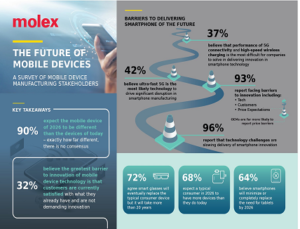
Molex unveiled the results of a global survey polling manufacturing stakeholders to identify the top trends and technologies shaping the future of mobile devices. Survey findings reveal continued evolution of mobile-device form factors, disruptive features and innovations that will impact smart phones, smart wearables and other mobile devices manufactured in 2026.
“The future of mobile devices shines brightest when envisioning the potential to transform nearly every aspect of our daily lives,” said Justin Kerr, vice president and general manager, Micro Solutions Business Unit, Molex. “Different device combinations and form factors will emerge to propel life-changing innovations in ‘connectedness’—from new healthcare apps and smart home hubs to mobile payments and other possibilities limited only by our imaginations.”
Molex commissioned Dimensional Research to conduct The Future of Mobile Devices global survey in July 2021, polling 207 qualified participants representing mobile device OEMs and suppliers. A variety of questions were asked to identify the features and timeframes for future mobile devices, as well as gauge the growing impact of 5G and connectivity innovations, along with barriers impeding overall progress.
No ‘Typical’ Mobile Device in 2026
Survey participants were asked a series of questions to help inform a depiction of typical smartphones and mobile devices in 2026. While responses identified various features, some of which are available already, others are likely further out on the horizon. As a result, no unanimous description emerged of a typical mobile device in 2026.
The top-five disruptive features most anticipated, and ranked in order, by respondents are self-charging; holographic or projection displays; fully recyclable; environment-proof, such as dust- or waterproof; and no-break displays. Also on the list are foldable devices, pop-up cameras, health biosensors, rollable devices and separation of device and display. Time will tell which features attain enough practical applications, market momentum and customer traction to become standardized in five years, if ever.
According to the survey, form factors (e.g., screen size, shape, etc.) also will evolve over the next five years. While 90% of those polled expect mobile devices to take on different form factors, there wasn’t consensus on whether they would be smaller, larger or different altogether. Nearly two-thirds believe demand for novel wearables will grow, including smart clothing (40%), glasses (33%), earpieces (29%) and watches (29%). Typical consumers will likely have more specialized devices by 2026, according to two-thirds of those polled. Still, 64% believe smartphones with integrated capabilities will minimize or replace the need for tablets.
Connectivity and 5G Lead Significant Innovations and Benefits
Respondents also were asked to rank up to five of the top features poised for the greatest amount of innovation in mobile devices manufactured in 2026. They cited data connectivity (42%), followed by wireless charging (36%), cameras (33%), Wi-Fi connectivity (28%) and built-in speakers (28%). Additionally, 82% expect consumers to reap significant benefits from 5G-enabled mobile devices by 2026. Ultra-fast 5G or mmWave ranked first (42%) in enabling technologies forecasted to drive disruption in mobile device manufacturing, followed by two-way wireless charging, optical waveguides for smart glasses, cameras with wafer-level optics, and nanoscale or micro-scale components.
Continued Focus on Solving Technology Challenges
Among mobile device OEMs and their suppliers, technology challenges remain that could impact plans for building future mobile devices. According to the survey participants, the most difficult problems to address are performance of 5G cellular connectivity (37%), high-speed wireless charging (37%), battery life (36%), sustainability (35%) and inability to produce small components at micro or nano scale (27%).
Molex Consumer & Commercial Solutions
Molex’s legacy of delivering critical connections extends across the entire mobile device ecosystem with proven expertise in 5G, mmWave, RF, signal integrity, antenna, power, camera and display technologies. Precision, volume manufacturing and miniaturization enable Molex to meet dynamic market demands while providing leading mobile device manufacturers and their suppliers with the smallest, densest and most advanced connectors currently available.


















